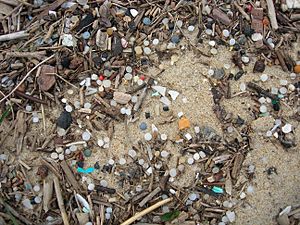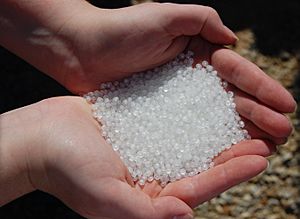Plastic pellet pollution
Plastic pellet pollution happens when tiny plastic pieces, called 'nurdles', escape into the environment. Nurdles are like the building blocks for almost all plastic products we use. They are melted down to make bigger plastic items. But sometimes, during their making or transport, these small pellets spill. When they get into our oceans and onto beaches, they cause lasting pollution. About 230,000 tonnes (that's 230,000,000 kilograms!) of nurdles might end up in the oceans every year. Because they are so small, sea animals often mistake them for food, which can be very harmful. It's also super hard to clean them up once they are spread out.
Contents
What Are Nurdles?
Nurdles are one of the biggest sources of tiny plastic pollution in the ocean. In the United States alone, about 27 million tonnes of nurdles are made each year. A single pound of plastic pellets can contain around 25,000 nurdles! Each nurdle is usually smaller than 5 millimeters (that's about the size of a lentil).
These plastic pellets are called "primary microplastics." This means they were made small on purpose, usually between 1 and 5 millimeters in size. Other tiny plastics, called "secondary microplastics," are formed when larger plastic items like water bottles break down over time. Primary microplastics make up a big part of the plastic pollution in our oceans. As more plastic is produced around the world, more nurdles are accidentally released into rivers and eventually the ocean.
One study looked at a plastic factory in Sweden. It found that between 3 million and 36 million plastic pellets could enter the environment from just one factory every year. These nurdles spill during production and shipping. Often, this happens because there aren't enough safety steps or rules in place.
How Nurdles Harm the Environment
Nurdles are a major part of the trash found in our oceans. Researchers studying beaches in Orange County, California, found that nurdles were the most common type of pollution. A study in Scotland even showed that nurdles on beaches were covered with harmful bacteria like E. coli.
Nurdles that escape into waterways or the ocean become a big problem for beaches and marine life. Studies show that these plastic pellets are mostly found in beach sand and sediments. They are usually made of common plastics like polyethylene or polypropylene.
When sea creatures eat nurdles, it can hurt them. The nurdles can release harmful chemicals, like phthalates, into their bodies. Nurdles can also pick up other dangerous pollutants from the seawater, like PCBs. For example, nurdles found near Japan's coast had up to a million times more PCBs than the surrounding water!
Tiny plastic beads, called microbeads, used in some face washes and other cosmetic products, also end up in the water.
Major Nurdle Spills and Events
2012 Incidents
In 2012, San Francisco Bay had to clean up after several nurdle spills.
Later that year, in Hong Kong, a powerful storm called Typhoon Vicente hit. It blew several shipping containers carrying over 150 tonnes of plastic pellets into the sea. These nurdles washed up on many southern Hong Kong beaches. Even though the company said nurdles aren't toxic on their own, the spill harmed marine life and killed fish on local farms.
2017 Incidents
About two billion nurdles (that's 49 tonnes!) spilled from a shipping container in Durban Harbor, South Africa. This required a huge cleanup effort. These nurdles were even found washing up on shores in Western Australia.
Also in 2017, a project called The Great Nurdle Hunt took place across the United Kingdom. This event helped people learn about plastic pellet pollution. An environmental group called Fidra asked people to share photos of nurdles they found on beaches. This helped them understand how widespread the pollution was. Earlier nurdle hunts in 2017 found that 73% of UK beaches had nurdle pollution.
2018 Incident
In 2018, a truck crash in Pennsylvania caused bright blue nurdles to spill into Pocono Creek and other waterways.
2020 Incident
During a thunderstorm in August 2020, a 40-foot shipping container full of 25 tonnes of nurdles fell into the Mississippi River in New Orleans. Sadly, no official cleanup happened because nurdles are not classified as "hazardous material," making it unclear who is responsible for cleaning them up.
2021 Incident
On June 2, 2021, a cargo ship called the X-Press Pearl sank off the coast of Sri Lanka. This caused a massive spill of chemicals and plastic nurdles. It became the worst environmental disaster in Sri Lanka's history.
2023 Incident
In January 2023, the French government announced it would take legal action because of a huge plastic pellet pollution problem along the coast of Brittany. It's believed these nurdles came from shipping containers lost in the Atlantic Ocean.
Solutions and Progress
Every year, 300 million tonnes of plastic are made, and over 14 million tonnes end up in the ocean. Plastic production keeps growing. All this trash in the ocean is a big threat to marine life. We need good rules and solutions to protect our oceans.
- The plastic industry is now paying more attention to plastic pellet loss. A program called Operation Clean Sweep was started in 2001. Its goal is "zero pellet loss" for plastic makers. This program gives companies a guide on how to reduce spills in their factories and offers training. However, companies don't have to report how many pellets they spill.
- In 2007, California passed a law called AB 258. This law set rules for plastic manufacturers to follow during production and transport to prevent nurdle spills. State officials can inspect factories to make sure they are following these rules.
- In 2008, California passed another "nurdle law." This law specifically calls pre-production plastic pellets (nurdles) a "pollutant."
- In 2015, the Microbead-Free Waters Act was passed. This law stops companies from making and selling primary plastic microbeads for cosmetic products. This ban helps reduce the amount of plastic pellets that end up in our oceans.
Raising Awareness
On April 11, 2013, artist Maria Cristina Finucci created "The Garbage Patch State" at UNESCO in Paris. This was done to raise awareness about ocean pollution. It was the first of many events supported by UNESCO and the Italian Ministry of the Environment.
The Great Nurdle Hunt is a "citizen science" project. This means everyday people help collect information about plastic pellet pollution around the world. The information they gather is used to talk with industries and lawmakers. The goal is to find ways to stop more pellet pollution from happening.
See also
 In Spanish: Contaminación por pellets de plástico para niños
In Spanish: Contaminación por pellets de plástico para niños
- Microbead
- Microplastics



